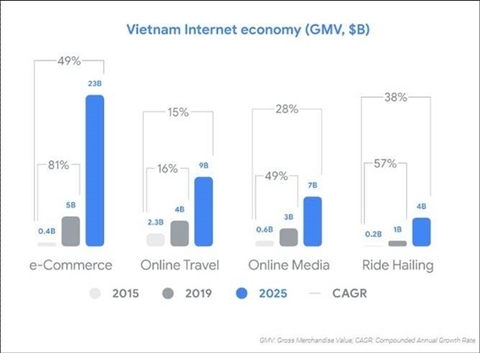 |
Indonesia and Viet Nam lead with growth rates of more than 40 per cent, while Singapore, Malaysia, Thailand, and the Philippines registered 20-30 per cent growth.
The e-Conomy Southeast Asia report for 2019 highlights the most significant industry trends observed in 2019 and analyses the current and future potential of the Southeast Asian internet economy across its six largest markets (Indonesia, Malaysia, the Philippines, Singapore, Thailand, and Viet Nam).
This surge across the region is attributed to an influx of around 100 million new online citizens in the last four years.
This growing market of customers has incentivised businesses in the region, from established ‘unicorns’ like Gojek to smaller enterprises, to adopt and leverage digital tools to expand rapidly.
Viet Nam's digital economy has topped $12 billion this year and is expected to surge to $43 billion by 2025, with e-commerce, online tourism, online communications and media, and ride-hailing being among the driving forces.
Viet Nam has 61 million Internet users, and a Vietnamese spends an average of three hours and 12 minutes daily on the internet on mobile devices such as smartphones.
As a region, Southeast Asian users spend most of their time on social networks and OTT apps (52 per cent), video apps (20 per cent), games (11 per cent), and other working utilities apps.
Viet Nam has become the third largest destination in the region for digital investment, with $600 million flowing in in 2018 and the first half of 2019, thanks to Ha Noi and HCM City, which are among the seven major internet economy developing cities in the region.
International investments in local tech firms including MoMo, Sendo and Topica have contributed to making Viet Nam a destination for investors.
As the world’s most engaged internet users, Southeast Asia is shaping technology trends.
When it comes to services like ride hailing and food delivery, the region is growing as fast as anywhere in the world, and that momentum is only going to continue as a new generation comes of age and people outside big cities come online.
By 2025 the regional Internet economy will have tripled to $300 billion, closing the gap with more developed markets in terms of GDP contribution.
Stephanie Davis, managing director, Google SEA, said, “Southeast Asia has an incredibly exciting digital economy as consumers are turning to digital to complete millions of tasks daily, resulting in unprecedented growth.
“However, there’s more to be done to realize digital’s incredible potential. Whether it’s providing support for small businesses to grow, teaching Southeast Asians digital skills, expanding Internet access to more people or advocating for smart policy and regulation.” — VNS
 The Southeast Asian internet economy has expanded by 39 per cent this year to hit US$100 billion for the first time, according to a report released by Google, Temasek and new partner Bain & Company on Thursday.
The Southeast Asian internet economy has expanded by 39 per cent this year to hit US$100 billion for the first time, according to a report released by Google, Temasek and new partner Bain & Company on Thursday.